
The War Scroll‚ part of the Dead Sea Scrolls‚ outlines an apocalyptic battle plan between the Sons of Light and Darkness‚ offering insights into ancient Jewish eschatology.
1.1 Overview of the Dead Sea Scrolls
The Dead Sea Scrolls‚ discovered between 1947 and 1956 in 11 caves near Qumran‚ are a collection of over 800 ancient manuscripts. Dating from 150 BCE to 70 CE‚ they include biblical texts‚ apocalyptic writings‚ and communal rules. The scrolls provide unparalleled insights into Jewish thought‚ religion‚ and culture during the Second Temple period. Written in Hebrew‚ Aramaic‚ and Greek‚ they reveal diverse perspectives on scripture‚ law‚ and eschatology. Their preservation has revolutionized biblical scholarship and deepened understanding of early Judaism and Christianity.
1.2 The Discovery of the War Scroll
The War Scroll was discovered in 1947 in Cave 1 near Qumran‚ alongside other Dead Sea Scrolls. This significant find‚ acquired by scholars‚ revealed a detailed eschatological battle plan. The scroll describes the final conflict between the Sons of Light and the Sons of Darkness‚ offering insights into ancient Jewish apocalyptic thought. Its discovery sparked excitement‚ as it provided a unique window into the beliefs and practices of the Qumran community‚ shedding light on their messianic expectations and military strategies.
1;3 Historical Significance of the War Scroll
The War Scroll holds immense historical significance as it reveals the apocalyptic worldview of the Qumran community. It provides insights into their military strategies‚ messianic expectations‚ and theological beliefs; The scroll is crucial for understanding ancient Jewish thought‚ particularly their vision of a final cosmic conflict. Its discovery has influenced scholarly debates on Jewish apocalypticism and early Christian texts. The War Scroll remains a vital source for studying the ideologies and practices of the Dead Sea Scrolls’ authors‚ offering a unique perspective on ancient religious and cultural movements.
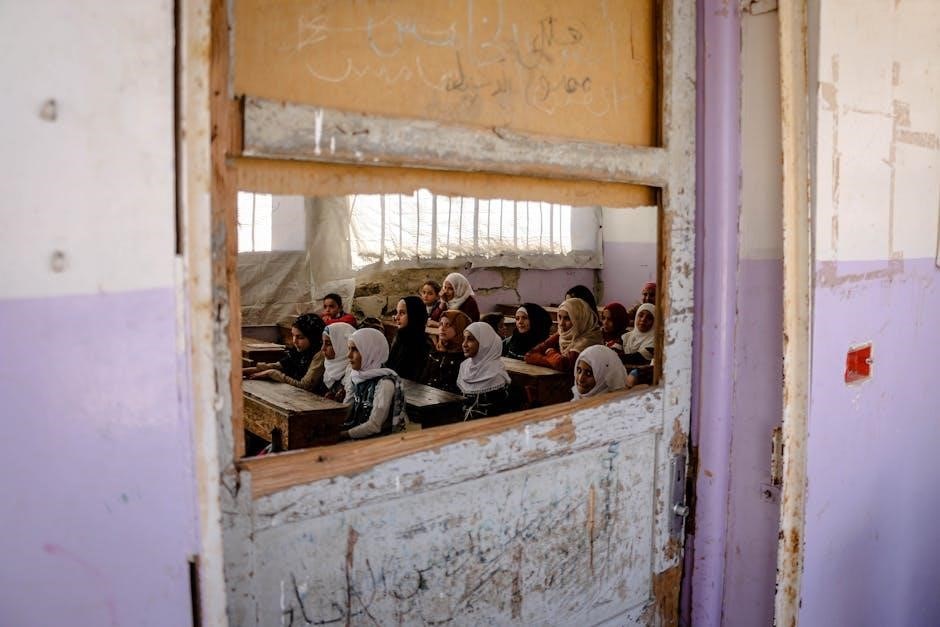
Historical Background of the War Scroll
The War Scroll‚ found in the Qumran caves near the Dead Sea‚ is linked to the Qumran community‚ active during the Second Temple period‚ detailing apocalyptic conflicts.
2.1 The Qumran Caves and the Dead Sea Scrolls
The Qumran Caves‚ located near the Dead Sea‚ are the site where the War Scroll and other Dead Sea Scrolls were discovered between 1947 and 1956. These caves‚ particularly Cave 1‚ yielded some of the most well-preserved scrolls‚ including the Great Isaiah Scroll and the War Scroll. The Qumran community‚ associated with the Essenes‚ is believed to have stored these texts‚ which provide valuable insights into Jewish thought and practices during the Second Temple period. The discovery revolutionized biblical scholarship and historical understanding of ancient Judaism.
2.2 The Sons of Light and the Sons of Darkness
The Sons of Light and the Sons of Darkness are central figures in the War Scroll‚ representing opposing forces in an apocalyptic conflict. The Sons of Light‚ led by divine guidance‚ embody righteousness and purity‚ while the Sons of Darkness‚ driven by evil‚ symbolize chaos and corruption. This dualistic framework reflects a broader theological theme in the Dead Sea Scrolls‚ emphasizing the cosmic struggle between good and evil. The War Scroll meticulously outlines their final battle‚ envisioning a triumphant victory for the Sons of Light‚ aligning with their messianic and eschatological beliefs.
2.3 The Apocalyptic Vision of the War Scroll
The War Scroll presents a vivid apocalyptic vision of a final‚ decisive conflict between the Sons of Light and the Sons of Darkness. This eschatological battle is meticulously detailed‚ with divine intervention ensuring the ultimate triumph of the righteous. The scroll describes a structured war plan‚ emphasizing the role of angels and messianic figures in the cosmic struggle. Its apocalyptic imagery reflects a dualistic worldview‚ where good and evil clash in a divine drama‚ culminating in the restoration of God’s order and the annihilation of darkness.

Structure and Content of the War Scroll
The War Scroll outlines battle plans‚ tactics‚ and divine intervention‚ structured in columns detailing the conflict between the Sons of Light and the Sons of Darkness.
3.1 The Battle Plan and Tactics
The War Scroll details a meticulously organized battle plan‚ outlining strategies for the Sons of Light against the Sons of Darkness. It includes tactical formations‚ weaponry‚ and leadership roles‚ emphasizing divine guidance and the importance of ritual purity. The text describes the annihilation of enemies‚ with specific instructions for each phase of the conflict‚ reflecting a blend of military practicality and religious ideology. The scroll’s military tactics reveal a sophisticated understanding of ancient warfare‚ integrated with apocalyptic visions of a final‚ decisive confrontation.
3.2 The Role of the Instructor and the Rule of War
The War Scroll designates the Instructor as a central figure‚ responsible for leading the Sons of Light in prayer and ensuring adherence to divine laws. The Instructor oversees the organization of troops‚ the conduct of rituals‚ and the moral purity of the warriors. This role emphasizes spiritual leadership‚ blending military strategy with religious devotion. The Rule of War dictates the order of battle‚ ensuring that all actions align with God’s will‚ reflecting a deep integration of faith and combat in the eschatological conflict.
3.3 The Heavenly Realm and Divine Intervention
The War Scroll vividly describes divine intervention in the final battle‚ with angelic forces aiding the Sons of Light. It portrays a celestial army fighting alongside the righteous‚ ensuring their victory. The text emphasizes God’s active role in the war‚ with divine judgment and salvation intertwined. This heavenly involvement underscores the scroll’s apocalyptic vision‚ where human and divine realms converge to establish eternal justice and destroy darkness. The narrative highlights the inseparability of faith and warfare in achieving cosmic redemption.
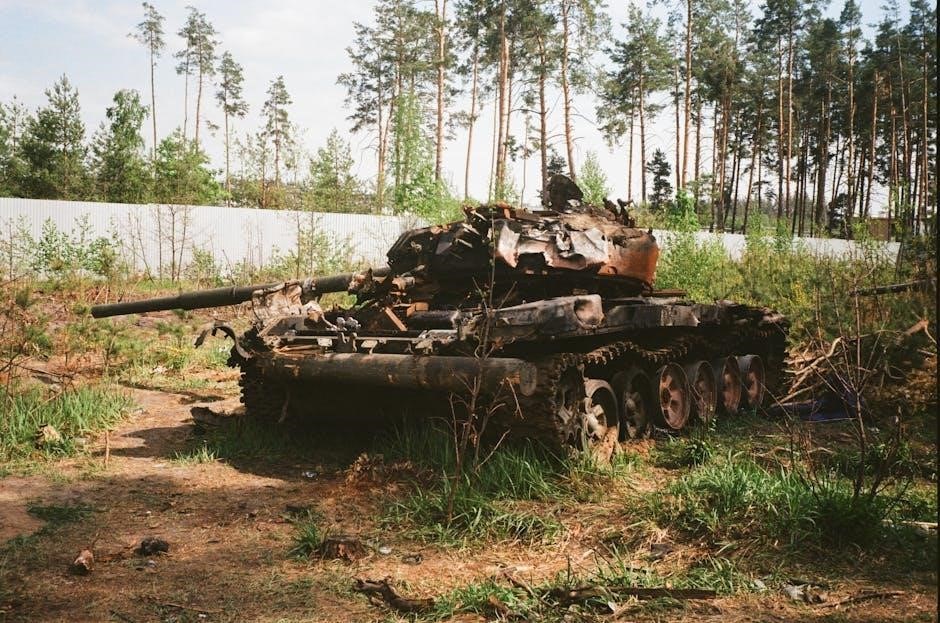
Theological Themes in the War Scroll
The War Scroll explores dualism‚ divine intervention‚ and predestination‚ emphasizing God’s role in the cosmic battle between light and darkness‚ shaping its theological and apocalyptic framework.
4.1 The Concept of Dualism: Light vs. Darkness
The War Scroll vividly portrays the cosmic conflict between the Sons of Light and the Sons of Darkness‚ symbolizing the eternal struggle between good and evil. This dualistic theme is central to its theology‚ with light representing righteousness and darkness embodying wickedness. The scroll depicts a divine predestination where the Sons of Light‚ guided by God‚ are destined to triumph over the forces of darkness‚ led by Belial. This stark division underscores the moral and spiritual dimensions of the apocalyptic battle‚ reflecting a clear eschatological vision of ultimate redemption and justice.
4.2 The Role of God in the War
The War Scroll portrays God as the supreme authority orchestrating the eschatological conflict. He supports the Sons of Light‚ ensuring their ultimate triumph over the forces of darkness. Divine intervention is central‚ with God predestining the outcome and guiding the battle. The scroll emphasizes God’s active role in the war‚ highlighting His justice and sovereignty; This cosmic judgment underscores the theological belief in God’s control over history and the final redemption of His people‚ reinforcing the scroll’s apocalyptic vision of divine triumph over evil.
4.3 The Idea of Predestination and Fate
The War Scroll reflects a strong belief in predestination‚ where the Sons of Light and Sons of Darkness are divinely assigned roles in the eschatological conflict. The outcome of the war is predetermined by God‚ emphasizing His sovereignty over history. The scroll blends divine predestination with human responsibility‚ as the Sons of Light must act in accordance with God’s plan. This theological framework underscores the inevitability of the final judgment and the triumph of righteousness‚ aligning with the broader apocalyptic worldview of the Dead Sea Scrolls.

The War Scroll and Its Relationship to Other Dead Sea Scrolls
The War Scroll shares thematic and structural links with texts like the Community Rule and the Temple Scroll‚ reflecting a cohesive apocalyptic vision and communal ideology.
5.1 The Community Rule and the War Scroll
The Community Rule outlines the organizational and ethical framework of the Qumran community‚ while the War Scroll details military strategies for the eschatological conflict. Both texts emphasize the duality of light and darkness‚ reflecting a shared theological foundation. The Community Rule establishes the moral and ritual guidelines for members‚ preparing them for the ultimate battle described in the War Scroll. This connection highlights the community’s dual focus on spiritual purity and apocalyptic warfare.
5.2 The Temple Scroll and Its Connection to the War Scroll
The Temple Scroll‚ another significant Dead Sea Scroll‚ provides detailed architectural and liturgical plans for a future temple. While focused on worship and ritual‚ it shares theological themes with the War Scroll‚ such as divine sovereignty and the ultimate triumph of righteousness. Both texts envision a purified cultic system and a restored Israel‚ reflecting a shared eschatological vision. Their connection underscores the Qumran community’s holistic view of religious and military preparedness for the coming divine intervention.
5.3 The Book of War and the War Scroll
The Book of War‚ another Qumran text‚ overlaps with the War Scroll in describing eschatological conflicts. Both texts detail battles between good and evil forces‚ emphasizing divine intervention. They share similar terminology and structural elements‚ such as lists of enemies and tactical descriptions. While the War Scroll focuses on the Sons of Light’s strategic preparations‚ the Book of War expands on the theological implications of these battles. Together‚ they provide a comprehensive view of the Qumran community’s apocalyptic expectations and their understanding of divine justice and cosmic warfare.

Scholarly Debates and Interpretations
Scholars debate the War Scroll’s composition‚ its relation to other Dead Sea Scrolls‚ and its apocalyptic imagery‚ reflecting diverse interpretations of its historical and theological significance.
6.1 The Identity of the Sons of Light
The Sons of Light‚ central to the War Scroll‚ are believed by many scholars to represent the Qumran community or a messianic group. Their identity remains debated‚ with interpretations ranging from a literal military order to a symbolic representation of righteousness. Some researchers link them to the Essenes‚ while others propose they embody a broader Jewish apocalyptic movement. Their role as divine warriors against the Sons of Darkness underscores their spiritual and eschatological significance in the text. This debate continues to shape understanding of the scroll’s historical context and purpose.
6.2 The Historical Context of the War Scroll
The War Scroll is believed to have been composed during the Second Temple period‚ with scholars debating its exact historical context. Some link it to the Qumran community‚ possibly the Essenes‚ while others suggest it reflects broader Jewish apocalyptic thought. The scroll’s apocalyptic themes and military strategies indicate a time of conflict or anticipation of divine deliverance. Textual evidence suggests it was copied around 140–100 BCE‚ aligning with the Hasmonean era or similar turbulent periods. This context underscores its relevance to Jewish resistance and eschatological hopes during that time.
6.3 The Apocalyptic Nature of the Scroll
The War Scroll embodies a vivid apocalyptic vision‚ detailing a divine conflict between good and evil. It describes the Sons of Light‚ led by heavenly forces‚ triumphing over the Sons of Darkness. The text emphasizes predestination‚ with God orchestrating the battle’s outcome. This eschatological narrative reflects a belief in a final‚ decisive confrontation‚ aligning with broader Jewish apocalyptic literature. The scroll’s vivid imagery and cosmic themes highlight its role in shaping early Jewish and Christian apocalyptic thought‚ offering insights into the theological and eschatological worldview of its authors.
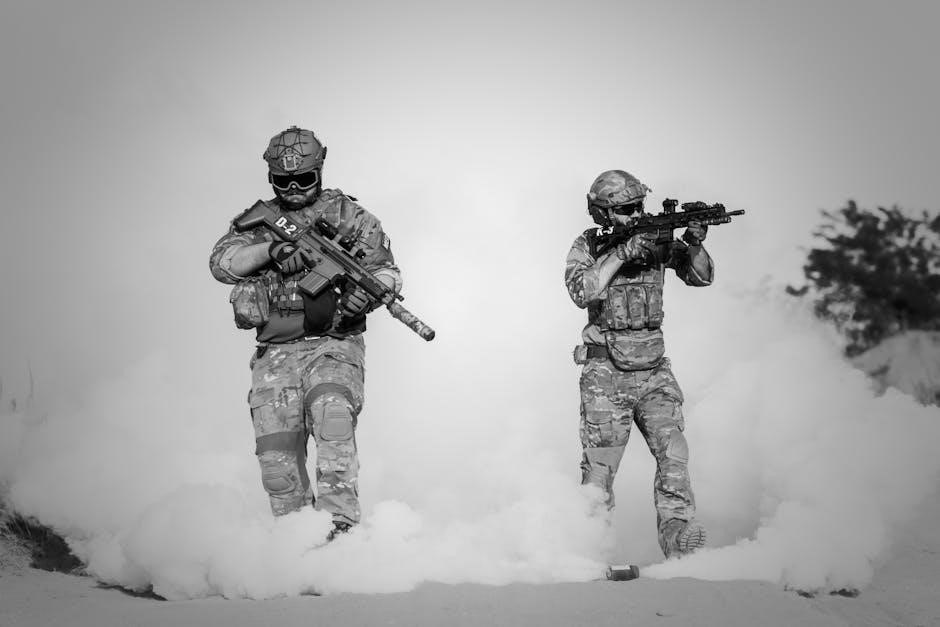
The War Scroll and Its Relevance to Jewish and Christian Thought
The War Scroll’s apocalyptic themes‚ such as divine judgment and messianic hopes‚ influenced Jewish eschatology and early Christian thought‚ reflecting shared theological concepts like dualism and divine intervention.
7.1 The Influence of the War Scroll on Jewish Apocalypticism
The War Scroll significantly shaped Jewish apocalypticism by detailing an eschatological battle between good and evil‚ emphasizing divine intervention‚ and outlining a messianic vision. Its dualistic framework influenced later Jewish texts‚ offering a structured narrative of cosmic conflict and redemption. The scroll’s themes of predestination and divine judgment resonated deeply‚ creating a theological foundation for understanding end-time events. This text remains a pivotal source in studying the evolution of apocalyptic thought within Judaism.
7.2 The Connection to Early Christian Texts
The War Scroll’s themes of dualism and divine intervention resonate with early Christian texts‚ particularly in apocalyptic literature like the Book of Revelation. Its structured battle plan and messianic expectations influenced Christian views on eschatology. The scroll’s emphasis on predestination and a final judgment aligns with Christian concepts of salvation and the ultimate triumph of good over evil. These parallels suggest a shared theological heritage‚ bridging Jewish and Christian traditions in their understanding of cosmic conflict and redemption.
7.3 The War Scroll and Modern Religious Movements
The War Scroll’s apocalyptic themes and dualistic worldview have inspired modern religious movements‚ particularly those emphasizing eschatology and divine judgment. Its imagery of cosmic conflict resonates with groups focused on end-time prophecies. The scroll’s structured battle plan and messianic expectations have influenced contemporary apocalyptic movements‚ shaping their views on morality and divine intervention. While not directly tied to any specific modern sect‚ its themes of predestination and divine sovereignty continue to inspire interpretations within various religious frameworks‚ reflecting its enduring influence on spiritual and eschatological thought.
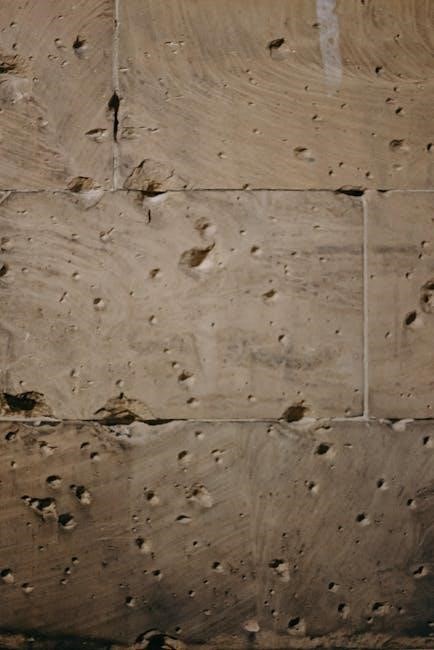
The War Scroll in Modern Scholarship
Modern scholars utilize advanced technologies and interdisciplinary approaches to study the War Scroll‚ enhancing understanding of its historical context and theological significance in ancient Judaism.
8.1 Recent Discoveries and Advances in Scholarship
Recent advancements in scholarship on the War Scroll include the use of AI technologies to analyze ancient texts‚ revealing new insights into its composition and historical context. Scholars have also discovered previously unknown fragments‚ shedding light on the scroll’s apocalyptic themes and battle strategies. Additionally‚ comparative studies with other Dead Sea Scrolls have deepened understanding of its theological significance. These discoveries continue to reshape scholarly interpretations of the War Scroll’s role in Jewish apocalypticism and its influence on early religious movements.
8.2 The Role of AI in Analyzing the Dead Sea Scrolls
AI has revolutionized the study of the Dead Sea Scrolls‚ including the War Scroll‚ by enhancing text reconstruction and analysis. Advanced algorithms can now decipher faded ink and fragmented texts with unprecedented accuracy. Researchers at the University of Groningen used AI to date the scrolls more precisely‚ revealing they are older than previously believed. Additionally‚ AI aids in identifying linguistic patterns and connections between scrolls‚ offering new insights into their historical and theological contexts. This technological leap is transforming Dead Sea Scrolls scholarship‚ making ancient texts more accessible to modern researchers.
8.3 The War Scroll in Contemporary Academic Discourse
The War Scroll remains a focal point in modern scholarly debates‚ with researchers exploring its apocalyptic themes and historical context. Recent studies highlight its significance in understanding ancient Jewish eschatology and militaristic ideologies. Academics are particularly interested in its depiction of divine intervention and predestination. The scroll’s connection to other Dead Sea Scrolls‚ such as the Community Rule‚ has also sparked discussions about its role within the Qumran community. Its relevance extends to broader conversations about religious conflict and the nature of divine justice‚ ensuring its continued importance in contemporary academic discourse.
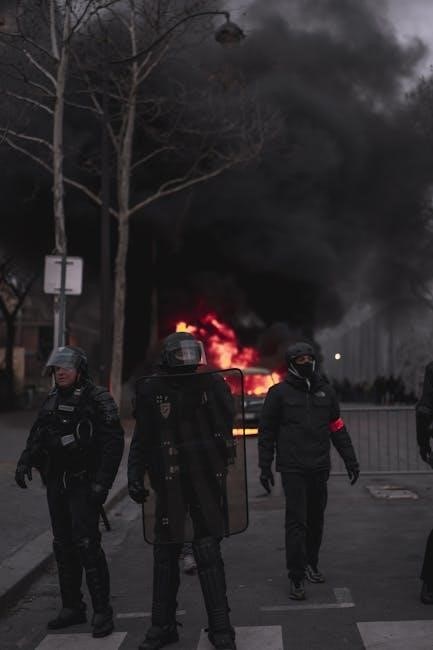
Translations and Editions of the War Scroll
The War Scroll is available in various translations‚ including works by Florentino Garcia Martinez and Michael Wise‚ offering insights into its apocalyptic themes and battle strategies.
9.1 The Dead Sea Scrolls Study Edition
The Dead Sea Scrolls Study Edition provides a comprehensive translation of the War Scroll‚ offering insights into its apocalyptic themes and battle strategies. Co-authored by Florentino García Martínez and Eibert Tigchelaar‚ this edition includes the original Hebrew text alongside an English translation‚ facilitating deeper understanding. It also features detailed annotations‚ historical context‚ and thematic analysis‚ making it a valuable resource for scholars and enthusiasts alike. The edition highlights the War Scroll’s significance within the broader collection of Dead Sea Scrolls‚ emphasizing its role in Jewish eschatology and communal practices.
9.2 The War Scroll: A New Translation
The War Scroll: A New Translation by Michael Wise offers a fresh interpretation of the text‚ enhancing readability while preserving its ancient nuances. This translation incorporates recent scholarly insights‚ providing a clearer understanding of the eschatological battle described; It includes detailed annotations and cross-references‚ making it accessible to both researchers and general readers. The work is part of a broader effort to make the Dead Sea Scrolls more accessible‚ ensuring the War Scroll’s themes of divine intervention and apocalyptic conflict remain relevant in contemporary study.
9.3 Critical Editions and Commentaries
Critical editions and commentaries on the War Scroll provide in-depth analysis‚ dissecting its historical and theological dimensions. Scholars like Florentino García Martínez and Eibert Tigchelaar offer meticulous textual reconstructions‚ while others explore linguistic and thematic complexities. These editions often include comparative studies with related Qumran texts‚ enhancing understanding of the scroll’s apocalyptic vision. Modern commentaries‚ such as those by Michael Wise and Martin Abegg‚ integrate archaeological findings‚ offering a holistic view of the War Scroll’s significance within the Dead Sea Scrolls corpus and its broader cultural impact.

The War Scroll and Its Cultural Impact
The War Scroll has influenced art‚ literature‚ and popular culture‚ inspiring works that reflect its apocalyptic themes; Its cultural significance extends through digital media and exhibitions‚ preserving its legacy.
10.1 The War Scroll in Popular Culture
The War Scroll’s vivid imagery has captivated popular culture‚ inspiring themes in films‚ books‚ and video games. Its apocalyptic battles and moral dualism resonate with modern audiences‚ making it a cultural icon.
10.2 The Scroll’s Influence on Art and Literature
The War Scroll’s vivid apocalyptic imagery and dualistic themes have profoundly influenced art and literature‚ inspiring authors and artists to explore its rich symbolism. Its depiction of cosmic battles and moral struggles resonates in works ranging from religious texts to modern novels. The scroll’s structured battle plans and divine interventions have also inspired visual representations in art‚ capturing the essence of ancient eschatology. This influence underscores the timeless appeal of the scroll’s themes‚ bridging ancient and contemporary creative expression.
10.3 The War Scroll in Digital Media and Exhibitions
The War Scroll has gained prominence in digital media through online exhibitions and scholarly platforms‚ offering global access to its contents. Digital preservation efforts‚ such as high-resolution scans‚ have made the scroll accessible to researchers and the public. Exhibitions at institutions like the Israel Museum showcase its significance‚ while documentaries and educational resources further enhance its reach. These digital initiatives ensure the scroll’s teachings and historical value remain relevant in modern academic and cultural discourse.
The War Scroll and Dead Sea Scrolls remain pivotal in understanding ancient Jewish thought‚ offering insights into apocalyptic visions‚ communal rules‚ and divine warfare‚ shaping modern religious discourse.
11.1 Summary of Key Points
The Dead Sea Scrolls‚ including the War Scroll‚ are ancient texts discovered near Qumran‚ offering insights into Jewish thought and apocalyptic visions. The War Scroll details a divine battle plan between the Sons of Light and Darkness‚ emphasizing dualism‚ predestination‚ and divine intervention. It outlines military tactics‚ the role of the Instructor‚ and the heavenly realm’s involvement. These texts significantly impact Jewish and Christian theology‚ providing historical context and influencing modern religious movements. Their study continues to evolve with new discoveries and scholarly interpretations‚ enriching our understanding of ancient religious practices and beliefs.
11.2 The Enduring Significance of the War Scroll
The War Scroll remains a vital text in understanding ancient Jewish apocalypticism and theology. Its detailed battle plans and divine narratives provide insights into the beliefs of the Qumran community. The scroll’s emphasis on dualism‚ predestination‚ and divine intervention continues to influence scholarly debates. Its relevance extends beyond academia‚ shaping religious thought and cultural interpretations. As a historical artifact‚ the War Scroll bridges the past and present‚ offering timeless themes that resonate in modern religious and intellectual discourse‚ ensuring its enduring significance in theological studies and historical research.
11.3 Future Research Directions
Future studies of the War Scroll should focus on integrating AI technologies for textual analysis‚ exploring its connections to early Christian texts‚ and examining its cultural impact in modern media. Scholars could also investigate lesser-explored sections for new theological insights. Additionally‚ comparative studies with other apocalyptic literature may reveal broader thematic patterns. Digital exhibitions and translations can enhance accessibility‚ fostering a deeper understanding of its historical and religious significance. These directions promise to unlock further layers of meaning within this ancient text‚ enriching both academic and public engagement with the War Scroll.

